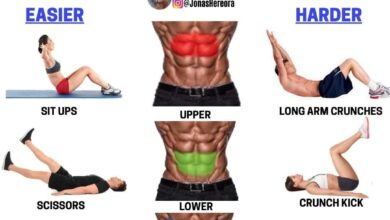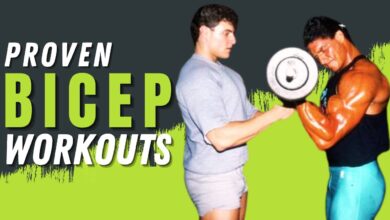
Unexpected Benefits of Low Impact Workouts
Unexpected Benefits of Low Impact Workouts: You might think of low-impact workouts as gentle and easy, but they offer a surprising range of benefits beyond just being kind to your joints. From boosting your cardiovascular health to building muscle strength and improving your mental well-being, these exercises can help you reach your fitness goals in a way that’s both effective and sustainable.
Low-impact workouts, as the name suggests, minimize stress on your joints and muscles. This makes them ideal for people of all ages and fitness levels, especially those who are new to exercise or recovering from an injury. While high-impact workouts often involve jumping and jarring movements, low-impact exercises rely on controlled movements and bodyweight resistance, making them a safer and more accessible option for many individuals.
Weight Management and Body Composition

Low-impact workouts can play a significant role in weight management and achieving a healthy body composition. While they may not burn as many calories as high-impact exercises in the same timeframe, they offer numerous benefits for individuals looking to lose weight or maintain a healthy weight.
Low-Impact Workouts and Calorie Expenditure
Low-impact exercises can contribute to calorie expenditure and fat burning through sustained effort and increased muscle mass.
- Increased Metabolism:Low-impact workouts can help boost your metabolism, leading to a higher calorie burn even when you’re not exercising. This is because regular exercise increases your resting metabolic rate, meaning your body burns more calories at rest.
- Improved Muscle Mass:While low-impact workouts may not build as much muscle as high-impact exercises, they can still contribute to muscle growth. Increased muscle mass boosts your metabolism, helping you burn more calories throughout the day.
- Longer Duration:Low-impact workouts can be performed for longer durations than high-impact exercises, allowing you to burn more calories over time. For example, a 30-minute walk can burn more calories than a 15-minute sprint.
Examples of Low-Impact Workouts for Weight Management
Several low-impact workouts can be incorporated into a weight management program.
- Walking:Walking is an excellent low-impact exercise that can be done anywhere, anytime. Aim for at least 30 minutes of brisk walking most days of the week.
- Swimming:Swimming is a great full-body workout that is easy on the joints. It provides resistance and helps build muscle strength.
- Cycling:Cycling is another effective low-impact exercise that can be done indoors or outdoors. Choose a comfortable pace and gradually increase the intensity as you get fitter.
- Yoga:Yoga combines stretching, strength training, and mindfulness. It can help improve flexibility, balance, and core strength, contributing to weight management.
- Pilates:Pilates focuses on core strength, flexibility, and posture. It can help improve muscle tone and burn calories.
Dietary Recommendations for Weight Management
Combining low-impact workouts with a balanced diet is crucial for effective weight management.
- Calorie Deficit:To lose weight, you need to consume fewer calories than you burn. This can be achieved by reducing portion sizes, choosing nutrient-rich foods, and limiting processed foods and sugary drinks.
- Hydration:Staying hydrated is essential for weight management. Water helps you feel full, boosts your metabolism, and aids in calorie burning.
- Nutrient-Rich Foods:Focus on consuming whole, unprocessed foods like fruits, vegetables, lean protein, and whole grains. These foods provide essential nutrients and keep you feeling full for longer.
Mental Health Benefits
Low-impact workouts are not only beneficial for your physical health but also play a significant role in improving your mental well-being. Engaging in regular low-impact exercises can significantly reduce stress, elevate your mood, and enhance cognitive function.
Low-impact workouts, like yoga or swimming, are known for their gentle nature, but they offer unexpected benefits beyond joint protection. For example, they can improve your mood and boost your energy levels, which are perfect for preparing for a festive gathering like Thanksgiving.
To add some vibrancy to your table, check out this article on 5 ways to fill your thanksgiving table with color. Once the festivities are over, you can return to your low-impact routine, feeling refreshed and ready to tackle the post-holiday blues.
Stress Reduction
Low-impact exercises can be a powerful tool for managing stress. When you engage in physical activity, your body releases endorphins, which have mood-boosting effects. Endorphins act as natural painkillers and have a calming effect on the nervous system.
This release of endorphins can help reduce feelings of anxiety and tension, leaving you feeling more relaxed and centered.
Low-impact workouts are a great way to get in shape without putting too much stress on your joints. But did you know that they can also have unexpected benefits like improving your sleep quality and boosting your mood? And while we’re on the topic of healthy habits, it’s worth considering the role of meal timing in weight loss.
You can learn more about the science behind does meal timing matter for losing weight on this website. Getting back to low-impact workouts, they are a great way to incorporate exercise into your routine without feeling overwhelmed, making them perfect for people of all fitness levels.
Improved Mood
Regular low-impact workouts can contribute to a more positive and optimistic outlook. Exercise has been shown to increase the production of serotonin and dopamine, neurotransmitters that play a crucial role in regulating mood. Serotonin is associated with feelings of happiness and well-being, while dopamine is linked to motivation and reward.
By increasing these neurotransmitters, low-impact workouts can help combat feelings of sadness, fatigue, and low energy, promoting a more positive emotional state.
Enhanced Cognitive Function
Low-impact exercises can also positively impact cognitive function. Physical activity, even at a moderate intensity, has been linked to improved memory, attention, and processing speed. This is because exercise increases blood flow to the brain, delivering more oxygen and nutrients, which are essential for optimal brain function.
Who knew low impact workouts could be so effective? They’re gentle on your joints, but still manage to build strength and endurance. And the best part? You can get a great workout in just a few minutes! Try my 9 minute total body bodyweight workout for a quick and effective routine.
You’ll be surprised how much you can accomplish in such a short time, and you’ll reap the rewards of low impact exercise, like improved cardiovascular health and reduced risk of injury.
Moreover, low-impact exercises can help stimulate the growth of new brain cells, a process known as neurogenesis.
Accessibility and Versatility
One of the most compelling reasons to embrace low-impact workouts is their remarkable accessibility and versatility. They cater to a wide range of individuals, regardless of age, fitness level, or physical limitations, making them an inclusive and adaptable form of exercise.Low-impact workouts can be seamlessly incorporated into various settings, from the comfort of your home to the invigorating outdoors or the structured environment of a gym.
This flexibility allows individuals to choose the location that best suits their preferences and circumstances.
Examples of Low-Impact Exercises, Unexpected benefits of low impact workouts
Low-impact exercises encompass a diverse range of movements that minimize stress on joints. These exercises can be categorized based on their execution location:
Home
- Yoga:A practice that involves a series of poses designed to improve flexibility, strength, and balance. Yoga can be modified to suit different fitness levels and can be done in a dedicated space at home.
- Pilates:A system of exercises that focuses on core strength, flexibility, and posture. Pilates can be performed on a mat or with specialized equipment, making it adaptable for home settings.
- Walking:A simple yet effective exercise that can be done indoors on a treadmill or outdoors on a variety of surfaces. Walking is a low-impact activity that can be easily adjusted to suit individual fitness levels and time constraints.
- Water Aerobics:Water provides buoyancy and resistance, making it an ideal environment for low-impact workouts. Water aerobics involves a variety of movements performed in a pool, offering a gentle and effective exercise option.
Outdoors
- Walking:Walking is a versatile exercise that can be enjoyed in parks, nature trails, or even around the neighborhood. It’s an excellent way to connect with nature while getting a low-impact workout.
- Swimming:Swimming is a full-body workout that is exceptionally gentle on joints. It provides a resistance workout while allowing for a comfortable and enjoyable experience.
- Cycling:Cycling is a low-impact exercise that can be done on stationary bikes or outdoors. It’s a great way to improve cardiovascular health and endurance while minimizing stress on joints.
Gym
- Elliptical Trainer:The elliptical trainer mimics the motion of walking or running but with less impact on joints. It provides a full-body workout, targeting major muscle groups.
- Rowing Machine:Rowing is a low-impact exercise that engages multiple muscle groups. It’s a great way to improve cardiovascular health, strength, and endurance.
- Stair Climber:Stair climbers provide a challenging cardiovascular workout while minimizing impact on joints. They can be adjusted to suit different fitness levels and can be found in most gyms.
Adaptability of Low-Impact Workouts
Low-impact workouts are highly adaptable, allowing individuals to tailor them to their specific needs and preferences. Here’s how:
Modifications for Different Fitness Levels
- Beginners:Beginners can start with shorter workout sessions and gradually increase duration and intensity as they gain strength and endurance. They can also focus on simpler exercises and modify them by reducing the range of motion or using lighter weights.
- Intermediate:Intermediate exercisers can increase the intensity of their workouts by adding resistance, incorporating more challenging exercises, or extending the duration of their sessions.
- Advanced:Advanced exercisers can continue to challenge themselves by incorporating advanced techniques, increasing the intensity of their workouts, or focusing on specific muscle groups.
Accommodating Physical Limitations
- Joint Pain:Individuals with joint pain can benefit from low-impact exercises that minimize stress on joints. They can choose exercises that focus on strengthening muscles surrounding the affected joints, improving flexibility, and reducing inflammation.
- Balance Issues:Low-impact exercises can be adapted to address balance issues. Exercises that focus on core strength, balance training, and proprioception (awareness of body position in space) can be beneficial.
- Other Physical Limitations:Low-impact workouts can be modified to accommodate a wide range of physical limitations, such as arthritis, osteoporosis, or injuries. Consulting with a healthcare professional or certified personal trainer can help develop a safe and effective workout plan.
Closure: Unexpected Benefits Of Low Impact Workouts
In conclusion, low-impact workouts offer a wide array of benefits that can positively impact your overall health and well-being. From reducing the risk of injuries to improving cardiovascular health, enhancing muscle strength and flexibility, and promoting mental well-being, these exercises provide a comprehensive approach to fitness that is accessible and enjoyable for everyone.
By incorporating low-impact workouts into your routine, you can unlock a wealth of benefits and embark on a journey toward a healthier and happier you.






